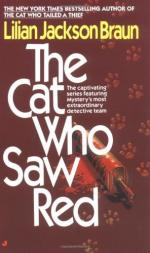|
This section contains 899 words (approx. 3 pages at 300 words per page) |

|
Written in the 1960s, The Cat Who Saw Red reflects America's social concerns in that era. Discussion groups might consider Maus Haus as an example of the communes popular in the 60s, but also as a successor to the artists' colonies of earlier generations. The relationship between Qwill and Joy Graham could be treated as an example of the so-called generation gap as the flower children struck an uneasy truce with their elders.
In particular, Joy's restlessness and her attitudes toward art seem typical of that period. Discussants might also explore the question of commitment as seen in the contrast between Joy's ambivalent feelings for Qwill and Qwill's devotion to the Siamese cats.
Like all the novels in the series, The Cat Who Saw Red explores the theme of isolation versus community. Qwill considers himself a loner but actually maintains deep friendships with the Rykers and...
|
This section contains 899 words (approx. 3 pages at 300 words per page) |

|




